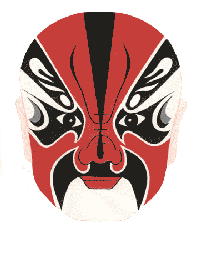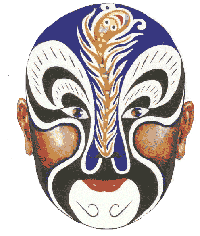 Colors
Colors
 In Peking Opera,lianpucolors are of great importance in revealing the age, profession and personality of a character. Originally, only three colors were used -- red, white and black -- each with its own symbolic meaning. Red is the color of loyalty, integrity and courage; black suggests a serious and taciturn disposition, including strength and roughness; white reveals a crafty and suspicious character. Later, other colors were gradually incorporated, such as purple -- the symbol of solemnity, serenity and a sense of justice; yellow, representing intelligence and calculation or bravery when used in warrior roles; blue shows uprightness and stubbornness; green indicates bravery and irascibility; and gold and silver are sometimes used on the faces of immortals, demons and monsters. Different colors can also distinguish nobility from the common folk, goodness from evil or loyalty from treachery.
In Peking Opera,lianpucolors are of great importance in revealing the age, profession and personality of a character. Originally, only three colors were used -- red, white and black -- each with its own symbolic meaning. Red is the color of loyalty, integrity and courage; black suggests a serious and taciturn disposition, including strength and roughness; white reveals a crafty and suspicious character. Later, other colors were gradually incorporated, such as purple -- the symbol of solemnity, serenity and a sense of justice; yellow, representing intelligence and calculation or bravery when used in warrior roles; blue shows uprightness and stubbornness; green indicates bravery and irascibility; and gold and silver are sometimes used on the faces of immortals, demons and monsters. Different colors can also distinguish nobility from the common folk, goodness from evil or loyalty from treachery.
 Patterns
Patterns
 Thejingrole in Peking Opera has many forms of facial make-up, including the "whole-face", "three-tile face", "quartered face", "six-division face", "tiny-flowered face" and "lopsided face". Each pattern is rooted in his ability to make subtle and interesting changes within the human face, and each pattern has its own symbolic meaning. Take Meng Liang -- the famous warrior of the Song Dynasty -- for example. His face is painted red with an inverted gourd on his forehead. This pattern represents his weapon, thehuo hu lu.
Thejingrole in Peking Opera has many forms of facial make-up, including the "whole-face", "three-tile face", "quartered face", "six-division face", "tiny-flowered face" and "lopsided face". Each pattern is rooted in his ability to make subtle and interesting changes within the human face, and each pattern has its own symbolic meaning. Take Meng Liang -- the famous warrior of the Song Dynasty -- for example. His face is painted red with an inverted gourd on his forehead. This pattern represents his weapon, thehuo hu lu.
Although painted faces are extremely stylized in their colors and patterns, no two painted faces are alike. For example, there are more than 100 face painting styles designed for Xiang Yu, the ruler of the Western Han Dynasty, and each one is very different.
Painted faces not only are used in facial make-up on the stage, but also have become a popular theme in Chinese folk art.Paper-painted faces made by artists sometimes look even more beautiful than those used on stage. In recent years, painted faces have developed into an independent art in China.
